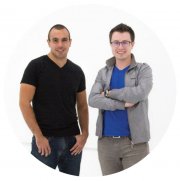“What we are doing is extremely ambitious, but someone will eventually pull it off — it might as well be us.”
That’s the kind of attitude that Tim Ellis is bringing to Relativity, a new company that aims to build orbital rockets with “zero human labor.” Ellis, B.S. AME ’12, M.S. AME ’13, co-
founded Relativity last year with Jordan Noone, B.S. AME ’14. The company raised more than $10 million in funding from Silicon Valley investors in less than six months, as well as investment from USC Viterbi’s Venture Fund.
Ellis and Noone envision Relativity playing a leading role in what they see as an inevitable part of human evolution: a migration of humans into space. They hope to develop off-planet manufacturing technologies by building rockets through what they call “creative design, lean development and automation.”
“We founded Relativity to use robots to build rockets, modernize the industry we are passionate about and have the most impact on the human species,” said Noone, who serves as Relativity’s CTO.
“Currently, there are close to zero people living off-planet, so automation would be required to build [just about] anything,” added Ellis.
The two met in 2010 as undergraduates at the USC Rocket Propulsion Lab (RPL), a student-run rocketry club aiming to become the first non-military undergraduate program to launch a rocket into space. Ellis, then a junior, recalled the day that Noone walked into the lab. He came in on fire, Ellis said, ready to lead and take charge of RPL even before the first day of classes. In fact, Noone did end up spending two years as the head of RPL, supervising five launches, two of which were attempts to reach space. Noone’s path to RPL and aerospace engineering was straightforward, but included additional coursework in biophysics at USC Dornsife that sharpened his appreciation of and focus on “elegant, integrated solutions,” he said. This interdisciplinary training was put to use at his first internship, in bio-inspired materials at HRL Labs in Malibu. Studying two disciplines also taught Noone that you could train your brain differently—and that, he said, was “ultimately very valuable.”
Ellis’ path to aerospace engineering was less direct. Originally from Plano, Texas, he was drawn to the West Coast for its culture of innovation, and thought he might become involved in the film industry. Strong in science and mathematics, he discovered the pull of engineering after hearing stories from a former girlfriend’s father about the engineering challenges (and pranks) he participated in while in college. Ellis, a USC Presidential Scholar, switched to aerospace engineering during summer orientation before his freshman year and found many parallels to the arts. He calls engineering “creativity with physics.”
Ellis also took on a leadership role at RPL, developing the first new rocket design code that RPL had created since the club’s founder, Ian Whittinghill, graduated. Ironically, Ellis says he didn’t love writing engineering code during his classes, but it was the very thing that kept him engaged at RPL. Coding, it turns out, led him to eventually fulfill the dream job he listed on his Presidential Scholar application: chief executive officer.
RPL serves as a training ground to learn the basics of planning and executing launches — understanding the regulatory environment, double checking, avoiding last-minute changes. Ellis and Noone said that this is where they learned to solve difficult engineering problems: RPL provided an open learning environment, allowing them a low-stakes opportunity to grow from their mistakes.
It also provided a critical network to the coveted positions in the boutique space industry. Ellis made his way into the private aerospace company Blue Origin on the referral of an RPL graduate, and later recruited Noone for an internship there. After Noone graduated, he accepted a job at SpaceX.
While the size of the task in front of them is not lost on Ellis and Noone, they remain undaunted. Both have experience developing sophisticated flight-qualified hardware. And they believe that the rapid fundraising success for their venture shows that investors support their vision and the journey ahead.
“If we are going to space as a species,” Ellis said, “we have to develop new technologies to do it. Right now, we are going against the most unbelievable odds of ‘not in our lifetime,’ to go see things outside the solar system. But that inspires us.”
Ellis and Noone want to create such transformative technologies because they believe they are part of something that is larger than themselves.
“Space is the biggest stage testing what it means to be human: curiosity meeting ambition,” Ellis said. “We need to be careful about the path we take because space is one of the most challenging problems out there, both from a fundamental physics and an economics perspective. It is easy to miss the business case, but we are carefully executing on our entrance strategy to this space — one which builds toward both short- and long-term goals.”
Robots, they said, are necessary to lower the cost of space travel and yield higher-quality rockets. In addition, employing robots to do mundane tasks allows people to do more creative design work. Noone, an admirer of the meticulous nature of Apple’s Steve Jobs, said that robots “free you to work on imaginative, creative and exotic solutions, versus the minutiae of repetitive tasks.”
Ellis and Noone are currently building their team at their Los Angeles headquarters, hiring USC Viterbi graduates and robotics experts, voraciously consuming academic articles and studying other industries. For instance, they have learned much about automation through their examination of the auto industry.
They feel a sense of urgency to hasten this gigantic wave of space exploration.
“We want to see this happen faster,” Noone said.




